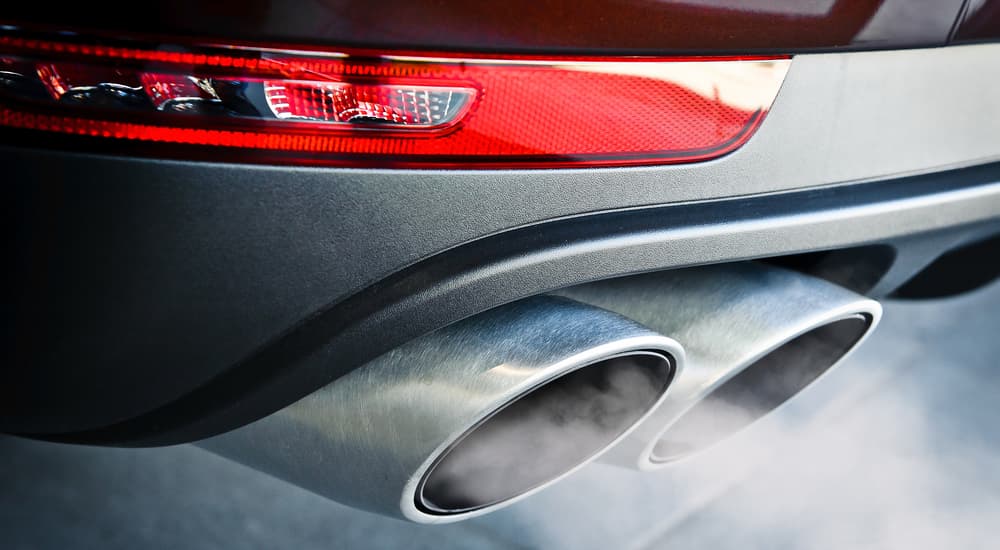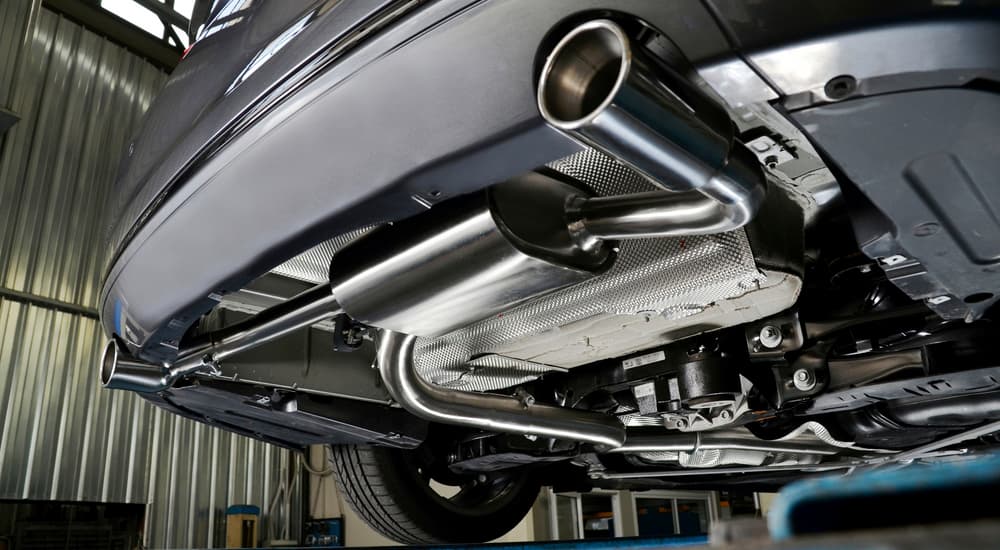For those looking to make their ride stand out, exhaust modifications are a popular approach. By replacing a vehicle’s stock exhaust with an aftermarket system, drivers can tune a car’s exhaust note until it’s music to their ears. This type of modification can lend a vehicle a distinctive roar that sets it apart just as well as a new paint job or a set of custom wheels and can even have some measurable benefits in terms of horsepower and fuel economy. That said, not all exhaust system modifications are created equal, and they can largely be broken down into two types: those which stay within the law and those which bend or outright break the rules in the pursuit of noise and power.
How Does an Exhaust Improve Performance?
How do exhaust system modifications improve a vehicle’s performance? Similar to the intake end of the vehicle, it’s all about airflow. Aftermarket air filters, cold-air intakes, and forced induction systems like turbochargers and superchargers are all popular ways of increasing the flow of air into the engine, and many exhaust system modifications––legal and illegal––serve much the same role.
The difference is that instead of increasing the flow of air into the engine, these systems are focused on improving the flow of exhaust gasses out of the engines, through the exhaust and out the tailpipe. The quicker and more efficiently these exhaust gasses can be expelled, the more air can flow into the engine, making exhaust modifications an effective way of maximizing performance and fuel efficiency. This trick is usually accomplished by removing restrictions from the exhaust system, increasing the overall diameter of the pipes, and otherwise increasing the flow of exhaust.

Types of Exhaust Modifications
First, let’s get into some of the most popular types of exhaust system modifications. These can include modifications that replace the exhaust system or individual components. While exhaust modifications can be as simple or complex as a driver’s imagination and mechanical ingenuity allow, they can largely be broken down into three types: axle-back exhausts, cat-back exhausts, and header/turbo-back exhausts. These terms might sound like automotive jargon to the uninitiated, but in reality, they’re simply describing how much of the exhaust system will be replaced as part of the modification process.
An axle-back exhaust modification, for example, only replaces the elements of the exhaust located from the back axle to the end of the exhaust system. A cat-back exhaust replaces everything from the catalytic converter down, while a turbo or header exhaust stretches all the way from the engine head or turbo to the tailpipe. Each has its own advantages in terms of performance, emissions, fuel economy, and sound, so here’s a close look to see how each system compares.
Axle-Back Exhausts
Given their relative simplicity when compared to other types of exhaust system modification, axle-back exhausts are by far the most popular––and most affordable––way to upgrade your vehicle’s exhaust. An axle-back exhaust usually replaces the muffler, tips, and a short section of piping used to connect the intermediate and mid pipe and are typically sold as relatively simple bolt-on kits that can be installed by any competent DIY-er.
Unlike the other types of exhaust system modifications, axle-back exhausts usually won’t have a measurable effect on a vehicle’s performance and fuel economy. Instead, these modifications are focused on improving the overall exhaust sound, providing the guttural roar that’s so effective at turning heads on the street.
One of the most popular types of axle-back exhaust system modifications is what’s known as a dual-tip exhaust. This approach effectively splits the tailpipe in two, allowing drivers to achieve some very satisfying symmetry when it comes to their exhaust system. While these dual-tip exhausts don’t have any measurable performance benefits, they can go a long way in giving even the most basic vehicle a high-performance look.
Cat-Back Exhausts
As we mentioned above, a cat-back exhaust replaces components from the catalytic converter on down. These modifications switch out everything from the extension pipe to the muffler, tailpipe, tailpipe extension, and exhaust tip and sometimes include a modified mid pipe. Unlike an axle-back exhaust modification, which is solely focused on improving a vehicle’s sound, a cat-back exhaust system can increase overall performance and fuel efficiency by up to five percent in terms of torque, horsepower, and fuel economy.
The performance improvements are accomplished through the use of larger diameter tubing and a less restrictive muffler, which enhance airflow and allow exhaust gasses to escape more quickly while improving the vehicle’s sound and reducing weight as an added bonus. Cat-back exhaust systems are relatively easy to install but are more expensive than the axle-back route, and getting the full performance gains often requires tuning the engine to match the exhaust.
Header/Turbo-Back Exhausts
For drivers seeking the ultimate in unrestricted airflow, header and turbo-back exhaust modifications are the go-to options. These systems stretch all the way from the vehicle’s header (or turbo in vehicles equipped with such forced induction systems) down to the exhaust tip, improving airflow in every section of the exhaust system and offering unsurpassed benefits in terms of performance, fuel economy, and sound. By increasing the size of the pipes and removing all the bottlenecks that restrict airflow, header and turbo-back exhaust modifications reduce backpressure in every part of the exhaust system.
These options also allow drivers the best level of control when it comes to tuning a vehicle’s exhaust to produce a certain sound, as they’ll essentially start with a blank slate onto which they can compose the exhaust note of their dreams. Unsurprisingly, header/turbo-back exhaust systems are the most expensive and time-intensive form of exhaust modification, requiring plenty of hours under the chassis and no shortage of mechanical know-how to install.

Illegal Exhaust Modifications
For drivers who aren’t as concerned with the law, there are plenty of aftermarket exhaust options on the market. These modifications are usually focused on bypassing the mufflers, making them illegal in most states. The law varies by jurisdiction, but almost every state in the country requires a muffler and has some sort of law on the books that prohibits any modification that increases a vehicle’s exhaust noise. Others limit exhaust noise to a certain decibel level, though this can often prove tricky when discussing vehicles that start off a lot loader, to begin with.
Removing a vehicle’s catalytic converter is another way to up the overall exhaust sound and improve airflow, but this is an illegal modification no matter where you’re driving, as federal law requires that all vehicles have a catalytic converter installed. However, it should be noted that these laws only apply to street-legal vehicles, which opens up the door to all sorts of exhaust-related experimentation on vehicles used for racing. If you have a dedicated track car––or feel like risking the wrath of the law––some popular exhaust modifications include.
Exhaust Cutouts
Exhaust cutouts are a popular option that allows drivers to switch between a normal, muffled exhaust and an unrestricted growl at the touch of a button. Installed between the exhaust system’s mid pipe and muffler, a cutout temporarily opens a vent that allows exhaust gasses to escape without passing through the muffler. These systems can be activated remotely, allowing drivers to let it roar whenever they choose––in theory allowing for a legal exhaust on the road and unrestricted airflow on the track.
For those who don’t want to bother with the remote-controlled aspect, another popular approach involves simply drilling holes in the muffler or exhaust pipe. While completely illegal and more difficult to conceal than the cutout method, it gets the job done if your only goal is to produce a louder exhaust note.
Exhaust Tips
While exhaust tips might not substantially increase the overall exhaust sound, they can alter it, allowing drivers to find a tone that fits their preferences. This modification won’t have any impact on performance but does allow a driver to tweak the vehicle’s sound and can look pretty flashy to boot. While many types of exhaust tips are perfectly legal, other types, like “whistle tip” exhaust modifications, run afoul of many state laws. These exhaust tips feature a smaller exhaust port, which creates a high-pitched whistling sound that is bound to stir up every dog within a two-mile radius.
Straight Pipes
The most extreme and illegal form of exhaust modification, a straight piped exhaust involves replacing the entire exhaust system with a straight pipe that runs all the way from the exhaust manifold to the tailpipe. By eliminating the resonator, muffler, and catalytic converter, drivers can create a hearty roar and enjoy some noticeable performance benefits as the vehicle can breathe easier and will likely be lighter with the absence of a full exhaust system. That said, it can be an expensive, time-intensive job that will only get pricer when you find yourself pulled over and slapped with a ticket.
What Is Your Goal?
Drivers who are considering an exhaust modification should start by asking themselves what they hope to accomplish. If the goal is simply improving a vehicle’s overall exhaust note, an axle-back exhaust or new exhaust tip might do the trick. If you are looking for some concrete benefits in terms of vehicle performance and fuel economy, a cat-back or header-back exhaust is just the ticket. The latter is always going to be more expensive, but if you’re looking to squeeze a few extra ponies out of your vehicle, they can play a big part in improving airflow.
Illegal exhaust modifications might be a tempting alternative for drivers looking to increase the volume of their exhaust system without the aid of a pricey aftermarket kit, but once you factor in the potential fines, they can quickly lose their luster. These should always be restricted to track-only cars. No matter which approach you take, always make sure to consult the state and local laws regarding exhaust sound and modifications.

